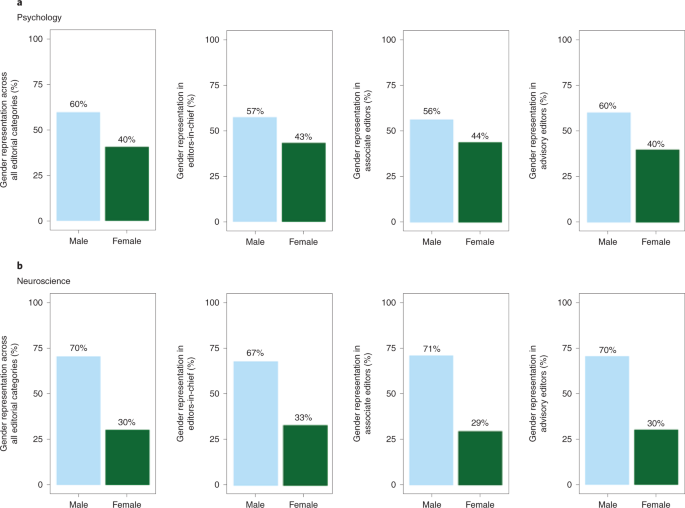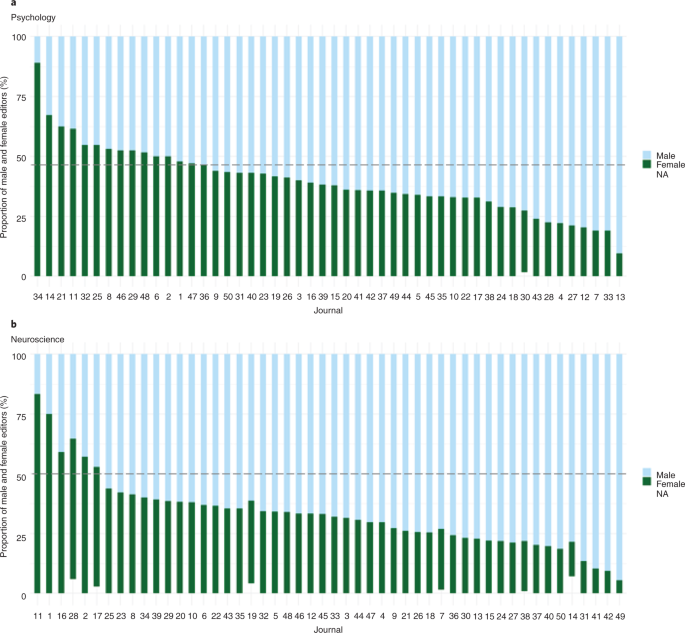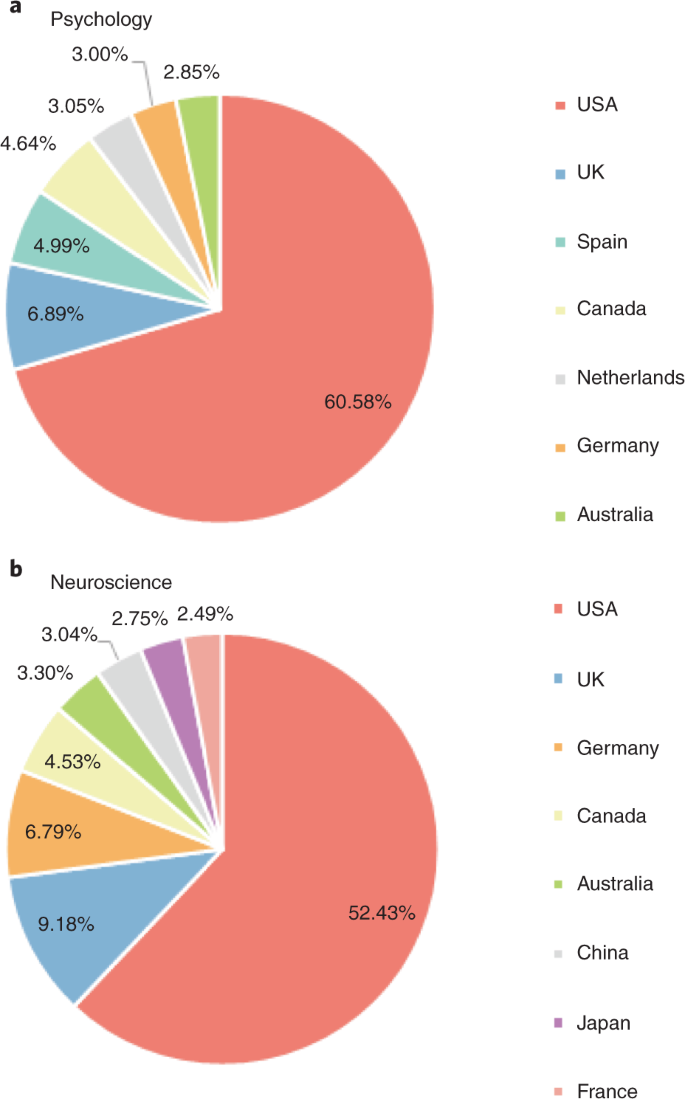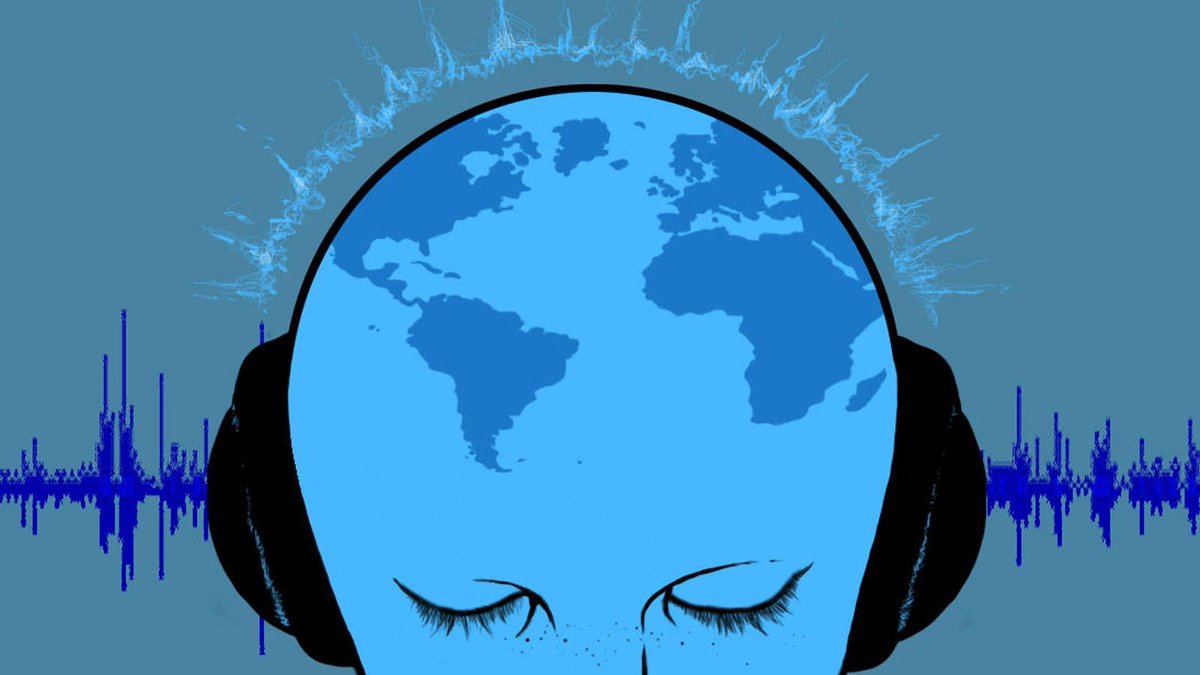Abstract
We reviewed publicly available information from the top 50 journals worldwide in psychology and neuroscience to infer the proportions of editors by gender and country of affiliation. In both fields, the proportions of male and female editors differed significantly, both across editorial roles and within various role categories. Moreover, for 76% of psychology journals and 88% of neuroscience journals more than 50% of editors were male, whereas only 20% and 10%, respectively, had a similar proportion of female editors. US-based academics outnumbered those from other countries as editors in both psychology and neuroscience beyond what would be expected from approximate rates of senior psychology and neuroscience scholars worldwide. Our findings suggest that editorial positions in academic journals—possibly one of the most powerful decision-making roles in academic psychology and neuroscience—are balanced in neither gender nor geographical representation.
Main
The landscape of psychology and neuroscience has changed dramatically over the past century with respect to gender, race and nationality. However, important gaps remain in career advancement, particularly in the later stages of career attainment1,2,3,4. While gender parity in tenure-track hiring decisions and promotion rates has improved, female academics remain underrepresented in senior career phases. For example, women outnumber men by approximately three to one in psychology graduate programs and make up approximately half of neuroscience graduate programs in the USA and Canada, and have done so for more than a decade5,6. Moreover, female early-career scholars are less likely than men to apply for tenure-track positions7; however, they are equally as likely, and perhaps even more likely, to be hired when they do8,9,10. Despite this, female scholars are underrepresented among the ranks of full professors8 and earn, on average, 88% of what their male peers do11.
Positions of power and indicators of eminence persist as areas of inequality12. Women are underrepresented among the ranks of public intellectuals, comprising, for example, only a quarter of authors listed in the ‘Gray Matter’ section of The New York Times1. Reports from the past decade have found that the editorial boards of leading scientific journals in medicine, psychiatry and neurology feature significantly more men than women13,14,15. To our knowledge, the fields of neuroscience and psychology have not been subjected to such an analysis (although see ref. 1 for an analysis of journals from the American Psychological Association and the Association for Psychological Science).
Journal editors exert considerable power over what is published, and by extension, the direction of an academic discipline and the career advancement of authors. It is important, then, to minimize biases extrinsic to the merit of the work impacting publication decisions. One way to achieve this is to ensure a diverse pool of editors, such that biases are diluted, and their influence reduced. This is in line with a diversity model16 of editorial appointment where editorial boards are structured to dismantle wider conditions of inequality. By contrast, a distributive model would seek an editorial board reflective of existing proportions in the field at large.
Internationalization has also been cited as an important goal in achieving diversity and innovation17. Previous research suggests that the geographical representation of journal article authors is associated with that of the editorial boards18,19. In an analysis of the editorial boards of the top 20 journals in 15 scientific disciplines, of which neuroscience was one, a significant logarithmic relationship was observed between the nationalities of editorial board members, and the number of publications originating from those countries20. While the directionality of these findings is difficult to ascertain, they highlight the potential for bias and hegemony in academic publishing and suggest that, in addition to gender, the geographical representation of editors is another important factor to consider when quantifying disparity in academic publishing.
There has been a recent emphasis in the aligned and overlapping fields of psychology and neuroscience on meta-scientific considerations of how such research is conducted2,21,22,23,24. These approaches consider how to improve the quality of the scientific literature by, for example, identifying and removing sources of bias. It is known that features such as gender and culture can influence the very processes that psychology and neuroscience are concerned with studying25,26. Similarly, the questions that are asked by researchers are influenced by their gender- and culture-based identities27,28,29. Biases also exist in the publishing process in psychology and neuroscience. For example, according to a 2016 analysis, less than a quarter of neuroscience manuscripts submitted to Nature Neuroscience had a female corresponding author30, and articles with female first and last authors in top neuroscience journals receive 30% fewer citations16. Psychology journals have seen relatively greater increases in male authors than female authors over time, suggesting a widening gender gap in authorship31. Diversity in the editorial boards of psychology and neuroscience journals is needed such that the experience of minority identities is valued, and thereby included, in the scientific literature2,32. To this end, it is important to investigate the current status of our editorial boards.
Here, we consider the top 50 English-language journals in psychology and neuroscience, as ranked by an independent source, Science Citation Index Expanded list in Clarivate Analytics’ Journal Citation Reports (JCR), in terms of the gender and geographical affiliation of their editors. We consider different categories of editor, in line with similar work14, to capture any differences based on relative decision-making power and role. Gender and country of affiliation were manually tabulated based on information available online. We statistically compared these results to the proportion of faculty and senior authors in psychology and neuroscience, in terms of gender representation and geographical affiliation, to infer whether representation of women and geographical regions on editorial boards was less than expected relative to the approximated wider representation in the field. Furthermore, the perspectives of randomly selected editors-in-chief at the journals featured were collected to inform on factors involved in editorial board selection. The goal is to provide quantitative data and some commentary on the current status of journal editing in these related fields, that can be used to monitor progress over time and act as a starting point for deeper quantitative and qualitative investigation of the reasons for any uneven representation, and remedial action.
Results
Editorial board analysis
Our first analysis considered gender representation in psychology. The sample included a total of 2,864 editors. Overall, there were significantly more male (n = 1,706) than female (n = 1,157) editors (Table 1 and Fig. 1a). This was primarily driven by the larger categories, namely category 2 (associate and section editors) and category 3 (advisory and editorial board members). There was no significant difference in gender representation among category 1, the smallest and most senior category (editors-in-chief and their deputies), although men (n = 49) outnumbered women (n = 37) in that category too. Data from 2017, 2 years before the data presented here, indicated that approximately 45% of full professors, 53% of associate professors and 65% of assistant professors in psychology in the USA were female33. The proportion of female editors (all categories) was significantly lower than expected based on the proportion of female faculty (χ2(1) = 10.39, P = 0.001). The proportion of female editors-in-chief was not statistically different from the proportion of female full professors (χ2(1) = 0.16, P = 0.688).
a,b, The overall proportion of editors who were male and female in the top 50 journals in psychology (a) and neuroscience (b), and in each of the three subcategories: (1) editors-in-chief and their deputies, (2) associate and section editors and (3) advisory and editorial boards.
The above analysis did not consider variability in the proportion of male and female editors at the individual journals. To quantify this, we calculated what percentage of journals had proportions of male and female editors in ten-point percentage increments. For over three-quarters of psychology journals (76%), more than half of editors were male, while for only 20% of journals were the majority of editors female (Fig. 2a). The interested reader can refer to Supplementary Data 1 for the specific journals in each position, denoted by number. Over half of the journals (54%) had more than 60% male editors, whereas only 8% had a similar proportion of female editors. Nearly a quarter of journals (22%) had more than 70% male editors, but only 2% showed a similar proportion of female editors. Additionally, 2% of journals had either more than 80% male or 80% female editors, and a further 2% had more than 90% male editors, with no journal having a similar proportion of female editors. Supplementary Fig. 1 shows the binned data by gender at the 50 journals.
a,b, The proportion of male and female editors at the top 50 journals in the fields of psychology (a) and neuroscience (b). The dashed gray horizontal line signifies an equal number of male and female editors. Journals are ranked from left to right by decreasing proportion of female editors.
Second, we considered geographical representation in psychology. Overall, the editors of the top 50 journals in psychology were primarily based in North America (65%), then, in decreasing order: Europe (26%), Asia (4%) and Oceania (4%), and finally Africa (0.5%) and Latin America (0.5%). This distribution was significantly skewed toward North America (χ2(5) = 3,973.2, P < 0.001). Regarding the country of affiliation, more than half of the editors were based in the USA (61%), followed by the UK (7%), Canada (5%) and Spain (5%). In the 4-year period leading up to this report, approximately 45% of senior authors in psychology journals were affiliated with the USA34 (see Supplementary Table 3 for all countries featured). Thus, based on this approximation, the proportion of editors affiliated with the USA was significantly greater than expected based on the number of senior authors affiliated with the USA (χ2(1) = 10.34, P = 0.001). The proportion of editors affiliated with the UK (χ2(1) = 0.48, P = 0.485), Canada (χ2(1) = 0.17, P = 0.674) and Spain (χ2(1) = 0, P = 1) was not significantly different from the number of senior authors affiliated with those countries. Supplementary Table 2 shows the proportion of editors from all countries that featured. Figure 3a shows the proportion of editors from each country that contributed more than 2% to the total number of editors in the field’s top 50 journals.
a,b, The proportion of editors at the top 50 journals in the fields of psychology (a) and neuroscience (b) by country of affiliation. For legibility, only countries represented by ≥2% of editors were included.
In terms of comparing the 50 journals, at over half (58%) of the top journals in psychology, 50% or more of the editors were affiliated with the USA. Furthermore, at over a quarter of the journals (26%), 75% or more of the editors were affiliated with the USA. Of the major contributing countries (≥4% of total number of editors in the field), there was a significant difference in the gender distribution of US-based editors (χ2(1) = 39.7, P < 0.001), which was 58% male and 42% female, UK-based editors (χ2(1) = 22.6, P < 0.001), which was 67% male and 33% female, Canada-based editors (χ2(1) = 10.49, P = 0.001), which was 63% male and 37% female, and Spain-based editors (χ2(1) = 15.9, P < 0.001), which was 68% male and 32% female.
Next, we considered gender representation in neuroscience. The sample included a total of 3,093 editors. Overall, there were significantly more male than female editors (Table 2 and Fig. 1b). This was the case at all editorial levels, with significant differences observed in the proportion of men and women in every category. In the USA, approximately 30% of full professors, 37% of associate professors and 45% of assistant professors in neuroscience in 2019 were female35. Based on these data, the proportion of female editors (all categories) at the top 50 journals was not significantly different from the proportion of female faculty members in the USA (χ2(1) = 0.41, P = 0.524). Similarly, the proportion of female editors-in-chief was not significantly different from the proportion of female full professors (χ2(1) = 0.43, P = 0.513).
In contrast to the 88% of neuroscience journals that had more than 50% male editors, only 10% of journals included a similar proportion of female editors (Fig. 2b). While 78% of neuroscience journals had more than 60% male editors, only 4% of journals had a similar proportion of female editors; 40% of journals had more than 70% male editors, compared with 4% with the same proportion of female editors; 10% of journals had either more than 80% or 90% male editors, compared with 2% and 0%, respectively, that comprised the same proportion of female editors. Supplementary Fig. 2 shows the binned data by gender at the 50 journals.
Finally, we considered geographical representation in neuroscience. Similar to psychology, editors at the top neuroscience journals were primarily based in North America (57%), followed by Europe (29%), Asia (9%), Oceania (4%), Latin America (1%) and Africa (<0.5%). This distribution was significantly skewed toward North America (χ2(5) = 4698.2, P < 0.001). In considering country of affiliation, we found that over half of the editors were based in the USA (52%), followed by the UK (9%), Germany (7%) and Canada (5%). During the 4-year period leading up to this report, approximately 36% of senior authors in neuroscience were affiliated with the USA34 (see Supplementary Table 3 for all countries featured). The number of editors affiliated with the USA was significantly greater than the approximate number of senior authors affiliated with the USA (χ2(1) = 11.11, P < 0.001). The number of editors affiliated with the UK (χ2(1) = 0.14, P = 0.712), Germany (χ2(1) = 0.48, P = .485) and Canada (χ2(1) = 0, P = 1) did not significantly differ from the approximate number of senior authors affiliated with those countries. Figure 3b shows the proportion of editors affiliated with each country that contributed more than 2% to the total number of editors analyzed.
In half of the top journals in neuroscience, 50% of the editors were affiliated with the USA. At 14% of the journals, 75% or more of the editors were affiliated with the USA. One journal, Annual Review of Vision Science, had only US-based editors. Of the major contributing countries (≥4% of total number of editors in the field), there was a significant difference in the gender distribution of US-based editors (χ2(1) = 218.7, P < 0.001), which was 68% male and 32% female, of UK-based editors (χ2(1) = 46.7, P < 0.001), which was 70% male and 30% female, of Germany-based editors (χ2(1) = 59.7, P < 0.001), which was 77% male and 23% female, and of Canada-based editors (χ2(1) = 7.8, P = 0.005), which was 62% male and 38% female.
Comments and perspectives on editorial board selection
Comments obtained from editors-in-chief at the journals analyzed suggests that recruiting female scholars to editorial roles can be challenging, and the lack of diversity in editorial boards (at least in terms of gender) does not reflect a lack of effort on their part. One editor-in-chief noted:
“When I was preparing to step into the role of editor-in-chief, I spent months recruiting my editorial team. I frankly lost count of the number of invitations I extended to women that were declined because of time pressures on them. Several women explicitly noted that taking on such a demanding role would not be appropriate given the number of obligations they have to family, students and collaborators. Only one man cited similar concerns (he and his partner were expecting a baby at the start of my term).”
Moreover, comments emphasized the role of tradition within psychology and neuroscience and their subfields, the impact of stereotypes and the slow pace of change:
“The countries represented in the journal are those that have academic traditions in the field, to the extent to which these traditions exist. This field grew out of psychology and economics, as practiced in the United States, Canada, United Kingdom, Australia, and particularly Israel. Often it was a small group of scholars in one country who inspired others. Even within specific countries, it is often one or two universities that contribute most of the work. The field was closer to mathematical psychology than to any other field, and, in those early days it was thought that ‘girls don’t do math’. This is empirically false, and girls have been getting that message for a few decades now. Thus, the field has more and more women, to the point where there will soon be a majority, but there is an age difference.”
“Our journal’s editor-in-chief and associate editors are all female, but our editorial board is definitely weighted toward males. My impression is that our field—like many others—has more females working in it overall but that the senior academics are still predominantly male. This probably has a flow-on effect in terms of editorial board membership, but it means that imbalances are perpetuated. It has certainly made me think about how I will constitute the editorial board next time I refresh its membership.”
The importance of diverse leadership and implementation of findings from diversity science was emphasized:
“I think you need more female leadership to make changes in these demographics. Many women have less time due to other responsibilities, but a role model helps to convince them that it’s doable.”
“Knowing some principles of diversity science, decision-makers should appoint editors by recognition (scan lists of senior people) rather than recall (seeing who comes to mind). Biases to follow the default (male) are stronger for free recall than recognition.”
Finally, comments also highlighted the potential positive effect that professional editorial boards have on gender representation:
“Gender balance tends to be common in professionally run journals (for instance, the chief editors across the 30 Nature journals are evenly split in terms of gender). Professional editors are no longer part of academia (that is, we used to be working scientists but left academia to become professional editors).”
Discussion
The present findings reveal that female scholars (as inferred by the authors based on publicly available information) are underrepresented in editorial board positions in the most popular journals (as indexed by impact factor) in psychology, and even more so in neuroscience. Moreover, in both fields there was a clear and significant geographical overrepresentation of editors affiliated with the USA in these (English-language) journals. The number of editors affiliated with the USA in each field was greater than the proportion of journals published in the USA, suggesting that even journals published outside the USA are skewed in favor of US editors. Data on the country of affiliation of senior authors in both psychology and neuroscience during the period prior to this report indicated significantly greater representation of the USA on editorial boards than participation in the field in general.
All categories of editor, bar the editors-in-chief of psychology journals, were characterized by significant differences in the proportion of men and women. This suggests that the findings probably do not reflect a pipeline problem within the ranks of editors, where one would expect an overrepresentation of women at lower ranks compared to higher ranks. Moreover, in psychology, there were fewer female editors (all categories) than expected based on female representation among psychology faculty (based on US figures), indicating that the reduced representation of women on editorial boards does not reflect a wider absence of women in the field. In neuroscience, by contrast, there was evidence that a paucity of women on editorial boards may reflect a wider absence of diversity in the field.
The disparities described were widespread, and not driven by a few ‘bad apples’. Ten times as many journals in neuroscience had more than 70% male editors (40%) compared with the same proportion of female editors (4%). The ratio was similar in psychology, with 22% of journals having more than 70% male editors compared to just 2% that had the same proportion of women. Only at a handful of journals did women editors outnumber men. Based on these data and the wider literature on academic publishing, one might argue that the ideas, values and decision-making biases of men, particularly those from the USA, are overrepresented in the editorial positions of the most recognized academic journals in psychology and neuroscience. We wish to emphasize, however, that these findings are based on publicly available information, not self-reported data.
The available pool of editors in a field may change over time. Gender ratios of undergraduate and graduate students in neuroscience and psychology have dramatically changed in recent decades, and English is currently considered the global language of science. Including journals published in languages other than English would probably have reduced the representation of the USA, and other primarily English-speaking countries such as the UK; however, we specifically targeted the highest-impact journals in the fields, which are published in English.
Why should the editorial boards of top journals endeavor to have a heterogeneous composition? Firstly, editorial positions are considered prestigious and influential, and probably impact the career advancement and networking opportunities of those who hold them. Secondly, research suggests that equity in science enhances productivity and innovation, and there is evidence that gender equity on editorial boards improves the review process36. Thirdly, representation may have a meaningful impact on the next generation of scientists. When undergraduates studying science, engineering and mathematics were randomly assigned to watch conference footage that depicted either male-skewed conference attendance (three men to every woman present) or balanced attendance (equal numbers of men and women), the female students who viewed skewed attendance reported less feelings of belonging than female students who viewed balanced attendance37. Male students’ sense of belonging was not impacted by either condition. Fourthly, positive changes in psychology and neuroscience may influence positive change in other academic disciplines.
As previously applied to citation practices16, journals and, in turn, readers and contributors to those journals must decide whether they wish to support a distributive or diversity model of editorial appointment. Proponents of a distributive model would seek an editorial board reflective of current proportions in the field at large. Applying a diversity model, by contrast, editorial appointment would be distributed such as to dismantle structural conditions of inequality. Editorial boards that are disproportionately populated by male academics from the USA may disproportionately value and publish scientific findings that are relevant to Western and/or male populations and cultures. It follows, therefore, that to remove barriers to the career advancement of those with minority identities in psychology and neuroscience, and to promote a scientific literature that is relevant to all, the composition of our leadership should be as diverse as possible. There may be fewer female and non-US-based scientists for editors-in-chief to select from when assembling their editorial boards. This will initially result in proportionally more of the available female scientists or scientists from smaller nations featuring on editorial boards. If academic fields wish to avoid restricting the career progression and scientific interests of women and non-US-based scholars, gender diversity and affiliation diversity of leadership positions in these fields should change.
While it is not possible for the present work to examine the reasons why gender disparity might exist in editorial boards, the perspectives shared by sitting editors-in-chief suggest both intrinsic (for example, biases that exist historically within a field) and extrinsic (for example, reduced time availability for female scholars) influences impede the recruitment of representative editorial boards. Their comments also highlight the role of stereotypes, and the slow pace of change. Building on these first-hand perspectives, there are several contributing factors that we wish to highlight. Female tenure-track academics in psychology earn less, publish less, are cited less and hold fewer grants than their male counterparts1,38. These differences may result in women being considered less worthy of positions on editorial boards. Reasons for this reduced productivity may be complex but they seem to include increased childcare demands over male colleagues—in the USA, mothers spend on average 75% more time performing childcare duties than fathers39—and reduced financial resources—male academics in biomedical and life sciences in the USA and the UK receive larger start-up funds than female academics40,41. The observation that professional editorial boards generally have better gender diversity than academic editorial boards suggests that performing editorial duties around a full-time academic appointment may disproportionately burden women.
In general, men and women report similar levels of motivation to engage in mentorship in the workplace42; however, it is unknown whether this extends to journal editing or reflects the values of men and women in neuroscience and psychology specifically. Evidence from the field of political sciences suggests that women faculty members were more likely to perform internal service roles (for example, departmental committee work), while men were more likely to perform higher-status external service roles, such as editing43. Follow-up work could consider whether female academics are being offered positions on editorial boards at similar rates to their male colleagues, and if so, what factors guide their constrained or unconstrained choices regarding editorial positions44. Such an approach will be necessary to understand whether anecdotal evidence of a difficulty in recruiting diverse editorial boards is borne out, and what factors would help to redress this. It is possible that expanding editorial boards, both in terms of size (and thereby decreasing the ‘service tax’ on each member but not removing opportunities from male scholars) and the range of individuals that are qualified to serve (for example, junior faculty), may be necessary. Departments might also actively encourage their faculty to participate in leadership roles, by providing the support and releasing time necessary to fulfill these duties within work hours.
Limitations
The limitations of this study reflect imprecise and limited data sources for editors’ identities and the fields at large, as well as representing a generalist view of psychology and neuroscience. To the first point, in line with similar work in related fields13,14,15, we assigned gender and country of affiliation based on publicly available information, and it is possible that we incorrectly determined some editors’ identities. Our study also did not consider many other traits and identities that may explain and enrich the implications of our data on gender and geographical affiliation, such as, for example, areas of double disadvantage and intersectionality (that is, the consequences of membership in multiple discriminated-against social groups45). A more detailed investigation, with institutional ethical approval, would have permitted us to contact editors directly. This would have also permitted data collection on race, sexual identity and disabilities, providing a more comprehensive report on the multiple intersecting identities of editorial teams in psychology and neuroscience. The importance of more detailed follow-up is evidenced by findings of underrepresentation of academics of color as authors and editors in psychology2. Nonheterosexual and gender-nonconforming academics often feel discouraged from expressing their identity. Of 1,427 science, technology, engineering and mathematics academics surveyed who identified as lesbian, gay, bisexual, trans, queer or asexual (LGBTQA) from the USA, the UK, Canada and Australia, fewer than half had disclosed their identity to the majority of their colleagues and many had disclosed to few or no colleagues46. Thus, women and non-US-based scholars who also have intersecting racial and/or sexual identities probably experience even less representation on editorial boards.
Secondly, an additional limitation of the study pertains to the data that were used to infer wider representation in the field. We included several sources of information on gender and geographical representation in psychology and neuroscience beyond journal editing, including US faculty and last-authorship data in Elsevier journals (Methods). Such data provided an approximation of expected frequencies against which to compare the current findings but are probably imperfect, as validation checks against a ground-truth were not possible. For example, last-authorship status alone is unlikely to be sufficient for admission to an editorial board, and is therefore an imperfect measure of available editors in the field at large. We also used conference attendance to infer wider representation in the field. Female scholars, however, face barriers to attending conferences, including fewer invitations and submission acceptances, childcare demands and harassment, and thus may attend at lower rates than male scholars4,47,48,49.
Finally, to address a remaining limitation that our findings may not capture several nuances, adding more journals and more in-depth analyses would have enabled us to capture data for subfields of psychology and neuroscience. We only statistically compared the proportion of editors derived from the major contributing countries, at the expense of countries with very little representation on editorial boards. This may mask interregional differences in representation within a continent. For example, when we state that the editors of the top 50 journals in psychology were primarily based in North America (65%), this does not mean that those editors were evenly distributed between the USA, Canada and Mexico. The views of the editors-in-chief who responded to requests for comment may not represent the perspectives of all editors. For example, those who were motivated to engage with the findings and respond with comments may represent the subsample of editors most engaged with topics of diversity and representation, generally. The current data represent only the highest-impact journals in the two fields, and may not be indicative of academic publishing in psychology and neuroscience as a whole.
We nevertheless hope the present work is a useful first step toward addressing representation in psychology and neuroscience journal editing. Among the psychology journals analyzed was Psychology of Women Quarterly. Unsurprisingly, the majority of editors at this journal are women. While the presence of this journal in the list is encouraging, suggesting that a journal that publishes research on the psychology of women and gender is also among the field’s most impactful, it also probably tipped the scales toward greater overall female editorial representation in psychology in this study.
Conclusions
Some areas of leadership in neuroscience and psychology are improving in terms of gender parity. The number of female presidents of the American Psychological Association, at 70% over the past decade, is the highest it has ever been1. In other areas, however, women continue to be underrepresented, including department chair positions38 and, as shown here, representation on the editorial boards of top journals.
It has been suggested that the people who practice science exert substantial influence on the types of questions that are asked, the evidence that is collected and analyzed, and the findings that are reported2. We would venture that the overrepresentation of men and those affiliated with the USA in editorial roles at the most influential journals in psychology and neuroscience impacts, and potentially skews, the publication decisions that affect not only the careers of scientists but also the science that is published. Future studies should explore the decisions undertaken by editors in this respect. Similarly, whether the overrepresentation of men and US-based academics noted here disproportionately effects the careers of scientists from underrepresented groups remains a pertinent question for future research.
In agreement with similar commentaries in related fields13,14, we reiterate the call for journals to define their policies and selection criteria for editorial board appointment, and to actively seek greater geographical diversity on their editorial boards. Some selection criteria, such as publication and citation counts, may themselves be biased against women and those based outside the USA, and should be revised. Finally, journals may need to amend the size of their editorial boards and the workloads assigned to their editors to foster a more welcoming environment to those with multiple responsibilities.
Methods
Editorial board analysis
To quantify the gender and geographical representation of editorial board members in psychology and neuroscience, the top 50 journals for the year 2019 in the fields of ‘psychology’ and ‘neuroscience’ were selected from the Science Citation Index Expanded list in Clarivate Analytics’ JCR. Selection was limited to journals published in the English language. This resulted in two databases of 50 editorial boards each (see Supplementary Data 1 and 2 for psychology and neuroscience databases, respectively). The lists generated contain the top 50 generalist journals, and as such may not contain high-impact journals within the subdisciplines of psychology and neuroscience. There was no overlap in the top 50 journals for the two fields.
Data collection
Journal webpages were audited for editorial board members. Manual data inspection and entry were conducted in October and November 2020, with a final check of the databases completed in the first week of December 2020. Any changes to editorial boards made after this time were not included in the databases. Each journal’s country of publication was downloaded from the JCR. The majority of the journals were published in the USA and the UK. Specifically, 58% of psychology journals and 40% of neuroscience journals were published in the USA, while 24% of psychology journals and 46% of neuroscience journals were published in the UK. Supplementary Data 1 and 2 provide the country of publication for all journals included.
Certain editorial positions, deemed not to be decision-making roles, were not included in the databases (for example, managing editors, student advisors and social media editors). Supplementary Table 1 provides a full list of excluded categories. One psychology journal, Journals of Gerontology Series B-Psychological Sciences and Social Sciences, listed separate editorial boards for psychological and social sciences. Owing to our focus, we only included the editors for psychological sciences in the database.
Names, role, country of affiliation and gender were manually tabulated based primarily on information available in journals’ public biographical sections for each editor. When gender and/or country of affiliation were not available on journal webpages, an internet search was conducted for these details, browsing institutional webpages, Google Scholar and so on. Pronouns were used as the most reliable indicator of gender, including nonbinary gender identities, but when not available, we had to make (arguably imprecise) inferences based on names and/or images. We acknowledge this as a major limitation of our work and our results represent inferences based on external characteristics rather than self-descriptions. When gender or country of affiliation could not be discerned, they were marked as ‘not available’ (n = 1 in psychology and n = 8 in neuroscience for gender).
Most journals had fewer than 150 editors (M = 156.97; s.d. = 972.61) with the exception of Frontiers in Psychology, which was a clear outlier (3 s.d. above the M number of editors), with a total n of 9,780 editors. In this case, we selected only the field chief editor and specialty chief editors (n = 40).
In line with similar research14, editors were categorized according to their role. Initially, four categories, following previous work14, were used: (1) editor-in-chief and deputies, (2) associate and section editors, (3) editorial board members and (4) advisory board members. The same title was used by different journals to denote varying levels of seniority, and so features in multiple categories. In these instances, decisions were made on an individual basis according to the organization of each journal. Supplementary Table 1 shows the roles assigned to each category. Ultimately, due to the infrequency of journals possessing both an editorial board and an advisory board, categories 3 and 4 were collapsed. As such, the final categorization was as follows: (1) editor-in-chief and deputies, (2) associate and section editors and (3) advisory and editorial board members.
Countries of affiliation were classified into six continents according to geographical location: North America (encompassing the USA, Canada and Mexico), Europe (encompassing the UK, continental Europe and Russia), Oceania (encompassing Australia and New Zealand), Latin America (encompassing Central and South America), Asia (including Turkey and the Middle East) and Africa.
Comparative data on wider gender and geographical representation in psychology and neuroscience
We wanted to assess whether the proportion of editors (by gender and geography) reflected the proportion of faculty academics (by gender and geography) in psychology and neuroscience. Regarding gender representation, we used data on the gender of US faculty members in neuroscience in 2019 and in psychology in 2017. Data for neuroscience were derived from the Society for Neuroscience Annual Meeting registration rates35. Data for psychology were derived from a report entitled Women, Minorities and Persons with Disabilities in Science and Engineering by the National Center for Science and Engineering Statistics33.
Regarding country of affiliation, we used raw data underlying an Elsevier (2020)34 report entitled The Researcher Journey Through a Gender Lens: An Examination of Research Participation, Career Progression and Perceptions Across the Globe. Here, we focus on last authorship, which often represents the most senior academic on a manuscript, for publications in psychology and neuroscience journals (as classified by Elsevier) during the 4-year period before our study (2014–2018). It is noticeable that there is some variability in data reported for the two fields. These differences reflect variability in data availability between psychology and neuroscience, and for the different characteristics studied. While it is possible there may be small changes in faculty representation and authorship over the 6-year period that we include, changes in hiring, promotion and publication rates have been found to be slow8,50, and are unlikely to have altered dramatically during this period.
Comments and perspectives on editorial board selection
To aid interpretation of the findings, particularly in terms of their perceived causes, a subsample of editors-in-chief at the journals featured in our report were randomly selected and invited to provide their perspective on the findings. A sample of these comments are reported in the ‘Results’ section, edited lightly for brevity, grammar and clarity, and interpreted further in the ‘Discussion’ section.
Statistical analyses
Analyses were conducted separately for psychology and neuroscience. One-sample chi-squared tests were used to determine if there were significant differences in the proportion of male and female editors overall in each field and in the three editorial categories, irrespective of the proportion of male and female editors at each individual journal. Any editors where the gender could not be reliably discerned were excluded, thus one editor was excluded from gender analyses in the field of psychology, leaving a final sample of 2,863 editors, and 8 editors were excluded from gender analyses in neuroscience, leaving a final sample of 3,085 editors. All excluded editors were from category 3, advisory and editorial board members. Because of the large number of editors in this category, we are confident that excluding these editors did not alter the results.
The overall proportion of male and female editors (and editors-in-chief) in each field was compared using chi-squared goodness-of-fit tests, to the approximated proportion of male and female (senior) faculty in each field. In a subsequent analysis, we considered differences in gender balance between the journals, by calculating the proportion of journals with distributions of male and female editors in ten-point increments from 0–100%.
One-sample chi-squared tests were also used to determine if there were significant differences in the proportion of editors affiliated with each continent and country. We then quantified how many journals were composed primarily of editors affiliated with the USA. In each field, the overall proportion of editors affiliated with each major contributing country was compared, using chi-squared goodness-of-fit tests, to the approximated proportion of senior authors in the field from that country.
Finally, we combined geographical and gender-based data, and quantified the proportion of male and female editors deriving from the major contributing countries. Following inspection of the geographical distribution of our data, we defined a major contributing country as any that contributed ≥4% of the total number of editors in a field.
Reference
-
Gruber, J. et al. The future of women in psychological science. Perspect. Psychol. Sci. 16, 483–516 (2020).
-
Roberts, S. O., Bareket-Shavit, C., Dollins, F. A., Goldie, P. D. & Mortenson, E. Racial inequality in psychological research: trends of the past and recommendations for the future. Perspect. Psychol. Sci. 15, 1295–1309 (2020).
-
Ryu, M. Minorities in Higher Education: Twenty-fourth Status Report (American Council on Education, 2010).
-
Llorens, A. et al. Gender bias in academia: a lifetime problem that needs solutions. Neuron 109, 2047–2074 (2021).
-
Fowler, G. et al. Women outnumber men in psychology graduate programs. Monitor on Psychol. 49, 21 (2018).
-
Stricker, E. M. The 2003 ANDP Survey of Neuroscience Graduate, Postdoctoral, and Undergraduate Programs (Association of Neuroscience Departments and Programs, 2003).
-
Webber, K. L. & González Canché, M. Is there a gendered path to tenure? A multi-state approach to examine the academic trajectories of US doctoral recipients in the sciences. Res. High. Educ. 59, 897–932 (2018).
-
Ginther, D. & Kahn, S. in The Economics of Economists: Institutional Setting, Individual Incentives and Future Prospects (eds. A. Lanteri et al.) 285–315 (Cambridge Univ. Press, 2014).
-
National Research Council. Gender Differences in Critical Transitions in the Careers of Science, Engineering, and Mathematics Faculty (The National Academies Press, 2010).
-
Williams, W. M. & Ceci, S. J. National hiring experiments reveal 2:1 faculty preference for women on STEM tenure track. Proc. Natl Acad. Sci. USA 112, 5360–5365 (2015).
-
National Science Foundation, National Center for Science and Engineering Statistics. Doctorate Recipients from US Universities: 2017 (Special Report NSF 19-301), https://ncses.nsf.gov/pubs/nsf19301 (2018).
-
Eagly, A. H. & Miller, D. I. Scientific eminence: where are the women? Perspect. Psychol. Sci. 11, 899–904 (2016).
-
Amrein, K., Langmann, A., Fahrleitner-Pammer, A., Pieber, T. R. & Zollner-Schwetz, I. Women underrepresented on editorial boards of 60 major medical journals. Gend. Med. 8, 378–387 (2011).
-
Hafeez, D. M. et al. Gender distribution in psychiatry journals’ editorial boards worldwide. Compr. Psychiatry 94, 152119 (2019).
-
Mariotto, S., Beatrice, G., Carta, S., Bozzetti, S. & Mantovani, A. Gender disparity in editorial boards of journals in neurology. Neurology 95, 489–491 (2020).
-
Dworkin, J., Perry, Z. & Bassett, D. S. (In)citing action to realize an equitable future. Neuron 106, 890–894 (2020).
-
Weick, K. E. in Publishing in the Organizational Sciences (eds Cummings, L. L. & Frost, P. J.) 284–296 (Sage, 1995).
-
Baruch, Y. Global or North American? a geographical-based comparative analysis of publications in top management journals. Int. J. Cross. Cult. Manag. 1, 109–126 (2001).
-
Granadino, B., García-Carpintero, E. & Plaza, L. M. La presencia española en consejos y comites deredaccion de revistas científicas internacionales: un instrumento para la promoción de nuestra ciencia [in Spanish]. Revista Española de Documentación Científica 29, 398–408 (2006).
-
García-Carpintero, E., Granadino, B. & Plaza, L. The representation of nationalities on the editorial boards of international journals and the promotion of the scientific output of the same countries. Scientometrics 84, 799–811 (2010).
-
Elson, M., Huff, M. & Utz, S. Metascience on peer review: testing the effects of a study’s originality and statistical significance in a field experiment. Adv. Methods Pract. Psychol. Sci. 3, 53–65 (2020).
-
John, L. K., Loewenstein, G. & Prelec, D. Measuring the prevalence of questionable research practices with incentives for truth telling. Psychol. Sci. 23, 524–532 (2012).
-
Pritschet, L., Powell, D. & Horne, Z. Marginally significant effects as evidence for hypotheses: changing attitudes over four decades. Psychol. Sci. 27, 1036–1042 (2016).
-
Simmons, J. P., Nelson, L. D. & Simonsohn, U. False-positive psychology: undisclosed flexibility in data collection and analysis allows presenting anything as significant. Psychol. Sci. 22, 1359–1366 (2011).
-
Markus, H. R. & Kitayama, S. Culture and the self: implications for cognition, emotion and motivation. Psychol. Rev. 98, 224 (1991).
-
Molenberghs, P. The neuroscience of in-group bias. Neurosci. Biobehav. Rev. 37, 1530–1536 (2013).
-
Bourke, B. Positionality: reflecting on the research process. Qual. Rep. 19, 1–9 (2014).
-
Medin, D. L. & Bang, M. Who’s Asking? Native Science, Western Science and Science Education (MIT Press, 2014).
-
Medin, D., Ojalehto, B., Marin, A. & Bang, M. Systems of (non-)diversity. Nat. Hum. Behav. 1, 1–5 (2017).
-
Promoting diversity in neuroscience. Nat. Neurosci. 21, 1 https://doi.org/10.1038/s41593-017-0052-6 (2018).
-
Ceci, S. J., Ginther, D. K., Kahn, S. & Williams, W. M. Women in academic science: a changing landscape. Psychol. Sci. Public Interest 15, 75–141 (2014).
-
Murray, D. et al. Author–reviewer homophily in peer review. Preprint at https://doi.org/10.1101/400515v3.full (2019).
-
National Center for Science and Engineering Statistics. Women, Minorities, and Persons with Disabilities in Science and Engineering, https://ncses.nsf.gov/pubs/nsf19304 (National Science Foundation, 2019).
-
De Kleijn, M. et al. The Researcher Journey Through a Gender Lens: An Examination of Research Participation, Career Progression and Perceptions Across the Globe, www.elsevier.com/gender-report (Elsevier, 2020).
-
Biaswatchneuro. Neuroscience base rates, https://biaswatchneuro.com/base-rates/neuroscience-base-rates/ (2020).
-
Wing, D. A., Benner, R. S., Petersen, R., Newcomb, R. & Scott, J. R. Differences in editorial board reviewer behavior based on gender. J. Womens Health 19, 1919–1923 (2010).
-
Murphy, M. C., Steele, C. M. & Gross, J. J. Signaling threat: how situational cues affect women in math, science and engineering settings. Psychol. Sci. 18, 879–885 (2007).
-
American Psychological Association, Committee on Women in Psychology. The Changing Gender Composition of Psychology: Update and Expansion of the 1995 Task Force Report, http://www.apa.org/pi/women/programs/gender-composition/task-force-report.pdf (2017).
-
Geiger, A. W., Livingston, G. & Bialik, K. Six Facts about US Moms (Analysis of American Time Use Survey Data), https://www.pewresearch.org/fact-tank/2019/05/08/facts-about-u-s-mothers/ (2019).
-
Sege, R., Nykiel-Bub, L. & Selk, S. Sex differences in institutional support for junior biomedical researchers. JAMA 314, 1175–1177 (2015).
-
Acton, S. E., Bell, A. J. D., Toseland, C. P. & Twelvetrees, A. Research culture: a survey of new PIs in the UK. eLife 8, e46827 (2019).
-
Ragins, B. R. & Cotton, J. L. Gender and willingness to mentor in organizations. J. Manag. 19, 97–111 (1993).
-
Mitchell, S. M. & Hesli, V. L. Women don’t ask? women don’t say no? bargaining and service in the political science profession. Political Sci. Politics 46, 355–369 (2013).
-
Xie, Y. & K. A. Shauman. Women in Science: Career Processes and Outcomes (Harvard Univ. Press, 2003).
-
Cole, E. R. Intersectionality and research in psychology. Am. Psychol. 64, 170 (2009).
-
Yoder, J. B. & Mattheis, A. Queer in STEM: workplace experiences reported in a national survey of LGBTQA individuals in science, technology, engineering, and mathematics careers. J. Homosex. 63, 1–27 (2016).
-
Knobloch-Westerwick, S., Glynn, C. J. & Huge, M. The Matilda effect in science communication: an experiment on gender bias in publication quality perceptions and collaboration interest. Sci. Commun. 35, 603–625 (2013).
-
Marts, S. Open secrets and missing stairs: sexual and gender-based harassment at scientific meetings, https://doi.org/10.13140/RG.2.2.14861.3376 (2017).
-
Schroeder, J. et al. Fewer invited talks by women in evolutionary biology symposia. J. Evol. Biol. 26, 2063–2069 (2013).
-
Bendels, M. H. K., Müller, R., Brueggmann, D. & Groneberg, D. A. Gender disparities in high-quality research revealed by Nature Index journals. PLoS ONE 13, e0189136 (2013).










